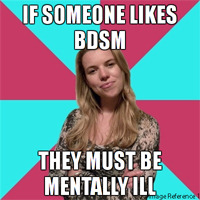BDSM & Mental Health
 A common misconception portrayed in the media about BDSM is that those who engage in this type of lifestyle are mentally imbalanced or unhinged. Kinksters can be regarded as mentally deficient, emotionally stunted or just downright "sick". There have been news stories in which BDSM came into media attention due to life threatening injuries sustained by kinksters. These stories have sex experts commenting on the dangers of kink and there is a strong undertone that BDSM is a "rarely curable pathology that afflicts those who cannot experience love and intimacy" (Sweeton, 2009).
A common misconception portrayed in the media about BDSM is that those who engage in this type of lifestyle are mentally imbalanced or unhinged. Kinksters can be regarded as mentally deficient, emotionally stunted or just downright "sick". There have been news stories in which BDSM came into media attention due to life threatening injuries sustained by kinksters. These stories have sex experts commenting on the dangers of kink and there is a strong undertone that BDSM is a "rarely curable pathology that afflicts those who cannot experience love and intimacy" (Sweeton, 2009).
 While certain aspects of the lifestyle carry an increased risk of danger, this does not mean that those who choose it are necessarily suffering from mental illness. Classifications of mental health and illness can vary depending on your location in the world. The diagnostic manual that is used in your area is also impacted by social acceptance. Psychology, as much as some of it is a science, is an art. The common conception of what is acceptable and considered appropriate mental health has changed and will continue to change as society changes. In previous years, for example, those who identified as gay were considered mentally ill; this has, thankfully, changed (Nichols).
While certain aspects of the lifestyle carry an increased risk of danger, this does not mean that those who choose it are necessarily suffering from mental illness. Classifications of mental health and illness can vary depending on your location in the world. The diagnostic manual that is used in your area is also impacted by social acceptance. Psychology, as much as some of it is a science, is an art. The common conception of what is acceptable and considered appropriate mental health has changed and will continue to change as society changes. In previous years, for example, those who identified as gay were considered mentally ill; this has, thankfully, changed (Nichols).
Mental Illness Defined in North America
 In North America, mental illness is defined by the Diagnostic Statistic Manual, currently the DSM 5. With each new edition of the DSM, statistic definitions are added, deleted, and modified and these criteria are the base line for diagnosis of mental disease. When considering the mental health of someone who enjoys engaging in an alternative lifestyle some important things to remember is that the DSM does take into account that fantasies, behaviors, and sexual urges must be the source of significant anguish or distress in occupational, social, or other crucial areas of functioning to be considered a disorder (Veaux, 2011). The other important thing to remember is that when a diagnosis of mental illness is made, a person is measured on 5 different axes to determine if that person truly falls into the range of mental illness. The different axes examine diverse angles to an individual's life and each axis includes a range of specific criteria (AllPsych and Heffner Media Group, Inc, 2004). These criteria encompasses the full spectrum of someone's life and account for more than if someone has some alternative tastes.
In North America, mental illness is defined by the Diagnostic Statistic Manual, currently the DSM 5. With each new edition of the DSM, statistic definitions are added, deleted, and modified and these criteria are the base line for diagnosis of mental disease. When considering the mental health of someone who enjoys engaging in an alternative lifestyle some important things to remember is that the DSM does take into account that fantasies, behaviors, and sexual urges must be the source of significant anguish or distress in occupational, social, or other crucial areas of functioning to be considered a disorder (Veaux, 2011). The other important thing to remember is that when a diagnosis of mental illness is made, a person is measured on 5 different axes to determine if that person truly falls into the range of mental illness. The different axes examine diverse angles to an individual's life and each axis includes a range of specific criteria (AllPsych and Heffner Media Group, Inc, 2004). These criteria encompasses the full spectrum of someone's life and account for more than if someone has some alternative tastes.
The DSM axes currently include:
(American Psychiatric Association, 2000)
Can Those Who Participate in BDSM Be Mentally Ill?
 While interest and engagement in BDSM is not a mental illness, any community can have individuals who suffer from mental illness. It is not something that occurs only in certain circles, so anyone may be susceptible depending on their history and genetic predespoitions. It is important that those who are experiencing these difficulties seek professional help for those afflictions. Research has already shown a concern that the stigma of BDSM may hinder access to mental health services (Hoff & Sprott, 2009). It is important to be supportive to your loved ones who are active members of the BDSM community. If you, or they, feel the need to seek professional help for any concerns regarding mental illness, they may need the extra comfort from you to battle the stigma of mental disease as well as any bias against their participation in kinky interests. If you are the one going to speak to someone, you should feel comfortable and willing to disclose BDSM activities to mental health professionals when it has bearing on your well being and mental well being.
While interest and engagement in BDSM is not a mental illness, any community can have individuals who suffer from mental illness. It is not something that occurs only in certain circles, so anyone may be susceptible depending on their history and genetic predespoitions. It is important that those who are experiencing these difficulties seek professional help for those afflictions. Research has already shown a concern that the stigma of BDSM may hinder access to mental health services (Hoff & Sprott, 2009). It is important to be supportive to your loved ones who are active members of the BDSM community. If you, or they, feel the need to seek professional help for any concerns regarding mental illness, they may need the extra comfort from you to battle the stigma of mental disease as well as any bias against their participation in kinky interests. If you are the one going to speak to someone, you should feel comfortable and willing to disclose BDSM activities to mental health professionals when it has bearing on your well being and mental well being.
Keep An Open Mind
There is no reason to think that someone who participates in kink has a mental illness and studies increasingly show that BDSM is more normal than many of us are led to believe. Keep an open mind and read more about the lifestyle and choices many kinksters make. BDSM and fetishes should not be the basis for the belief that someone needs professional help, that need would also be reflected in other areas of their life as well.
Article References
AllPsych and Heffner Media Group, Inc. (2004, 05 15). Diagnostic and Statistical Manual of Mental Disorders, Fourth Edition (DSM-IV). Retrieved 11 01, 2011, from ALLPsych Online: http://allpsych.com/disorders/dsm.html
American Psychiatric Association. (2000). Diagnostical Statistical Manual of Mental Disorders Fourth Edition. Washington: American Psychiatric Association.
Hoff, G., & Sprott, R. (2009). Therapy Experiences of Clients with BDSM Sexualities:Listening to a Stigmatized Sexuality. Electronic Journal of Human Sexuality, Volume 12
Nichols, M. (n.d.). Psychology And BDSM: Pathology Or Individual Difference?.Retrieved 10 24, 2011, from Institute for Personal Growth: http://www.ipgcounseling.com/psychology_and_bdsm.html
Sweeton, J. (2009, 04 14). What's dangerous about BDSM?. Retrieved 10 25, 2011, from Psychology Today: http://www.psychologytoday.com/blog/out-the-ordinary/200904/whats-dangerous-about-bdsm
Veaux, F. (2011, 10 31). What? Why? How? A brief introduction to BDSM. Retrieved 11 05, 2011, from BDSM?: http://www.xeromag.com/fvbdsm.html
Image References
Someone else's art deserves recognition! The images presented in this article were borrowed from the following places:
Header Image: http://i.kinja-img.com/gawker-media/image/upload/s--p0ug6IOD--/c_fit,fl_progressive,q_80,w_636/18pamhipf3t2sjpg.jpg | Retrieved April 15, 2015
Image 1: http://29.media.tumblr.com/tumblr_ll0s0fGhRX1qgy0fio1_400.png | Retrieved November 16, 2011
Image 2: http://i2.squidoocdn.com/resize/squidoo_images/250/draft_lens13915921module128382661photo_1294611184LovinglyOwned.png | Retrieved November 16, 2011
Image 3: http://www0.alibris-static.com/isbn/9780880484152.gif | Retrieved November 16, 2011
Image 4: http://i42.tinypic.com/9sfn6b.jpg | Retrieved November 16, 2011